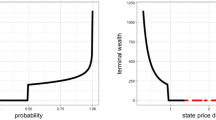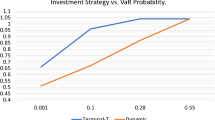Abstract
We show in this article that bang-bang portfolio strategies where the investor is alternatively 100% in equity and 100% in cash are dynamically inefficient. Our proof of this result is based on a simple second-order stochastic dominance (SSD) argument. It implies that this is true for any decision criterion that satisfies SSD, not necessarily expected utility. We also examine the stop-loss strategy in which the investor is 100 percent in equity as long as the value of the portfolio exceeds a lower limit where the investor switches to 100 percent in cash. Again, we show that this strategy is inefficient under second-order risk aversion. However, a slight modification of it–in which all wealth exceeding a minimum reserve is invested in equity–is shown to be an efficient dynamic portfolio strategy. This strategy is optimal for investors with a nondifferentiable utility function.
Similar content being viewed by others
References
Arrow, K. (1970). Essays in the Theory of Risk Bearing. Amsterdam and London: North Holland.
Dybvig, P. H. (1988). “Inefficient Dynamic Portfolio Strategies or How to Throw Away a Million Dollars in the Stock Market,” Review of Financial Studies 1, 67–88.
Eeckhoudt, L., C. Gollier, and H. Schlesinger. (forthcoming). “The No-Loss Offset Provision and the Attitude Towards Risk of a Risk-Neutral Firm,” Journal of Public Economics.
Gollier, C. (1996). “Repeated Optional Gambles and Risk Aversion,” Management Science 42, 1524–1530.
Gollier, C., and R. J. Zeckhauser. (1996). Time Horizon Length and Risk-Aversion. Unpublished manuscript, University of Toulouse, France.
Mossin, J. (1968). “Optimal Multiperiod Portfolio Policies,” Journal of Business 41, 215–229.
Pratt, J. W. (1964). “Risk Aversion in the Small and in the Large,” Econometrica 32, 122–136.
Pratt, J. W. (1987). “Multiattribute Utility and Derived Utility.” in Y. Sawaragi, K. Inoue, and H. Nakayama (eds.), Towards Interactive and Intelligent Decision Support Systems, Proceedings of the Seventh International Conference on Multiple Criteria Decision Making, Kyoto, Japan, 1986.
Rothschild, M., and J. Stiglitz. (1970). “Increasing I: A Definition,” Journal of Economic Theory 2, 225–243.
Roy, S, and R. Wagenvoort. (1996). “Risk Preference and Indirect Utility in Portfolio Choice Problems,” Journal of Economics 63, 139–150.
Samuelson, P. A. (1963). “Risk and Uncertainty: The Fallacy of the Law of Large Numbers,” Scientia 98, 108–113.
Samuelson, P. A. (1989). “The Judgement of Economic Science on Rationale Portfolio Management: Indexing, Timing, and Long-Horizon Effects,” Journal of Portfolio Management 7, 3–12.
Segal, U., and A. Spivak. (1990). “First Order versus Second Order Risk Aversion,” Journal of Economic Theory 51, 111–125.
Author information
Authors and Affiliations
Rights and permissions
About this article
Cite this article
Gollier, C. On the Inefficiency of Bang-Bang and Stop-Loss Portfolio Strategies. Journal of Risk and Uncertainty 14, 143–154 (1997). https://doi.org/10.1023/A:1007725428360
Issue Date:
DOI: https://doi.org/10.1023/A:1007725428360




